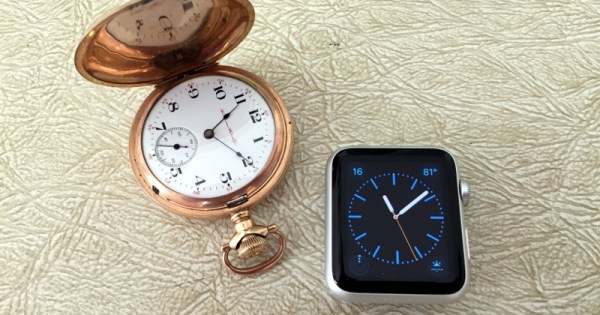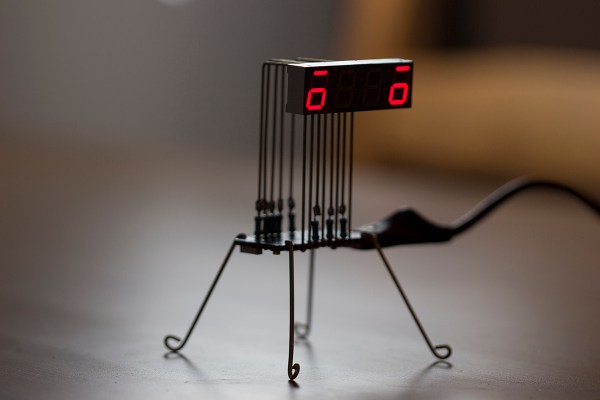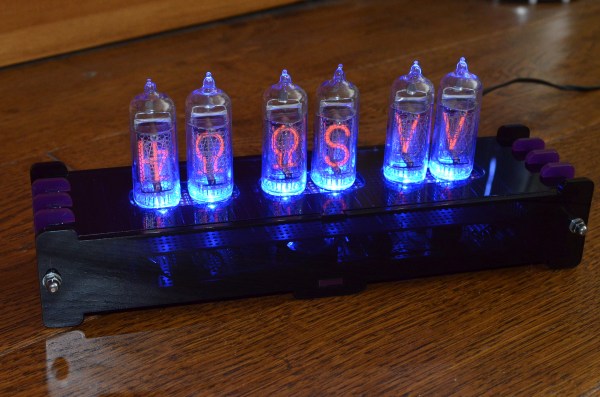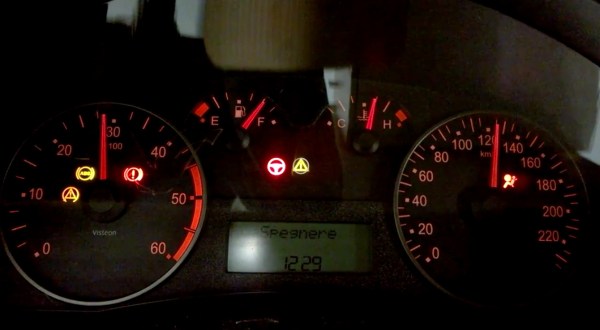Mechanical watch enthusiasts see the Apple watch as a threat to the traditional gear train. It does not tick, requires frequent re-charging, and it’s certainly not the most attractive of watches. But it can direct you to the local coffee shop, allow you to communicate with friends anywhere in the world, get you onto an airplane after the most awkward of arm gestures, and keep you apprised of the latest NCAA basketball scores. Is the advent of the smart watch the end to the mechanical watch?
Continue reading “Mechanical Watch Hacker Gets An Apple Watch”
clock hacks988 Articles
Cute Countdown Timer Reminds You Of Impending Doom
As things get busy, whether it be an upcoming product launch, a pregnancy, or even the release of your favorite game (or movie!) sometimes it’s nice to have a little countdown timer. Not an app on your phone, but a tangible, physical timer to set on your desk. Which is why SevenSeg is such a cute idea.
[Mohit] wanted to design something that was simple, but aesthetically pleasing — he’d seen free-form electronic projects before and wanted to give it a shot. What he came up with is pretty elegant! A seven segment display is connected via 1/32″ brass rods to the controller, a Particle Photon — which is kind of like a Teensy with WiFi for the internet of things. After putting a few resistors in line with the display, and a bit of frustrating bending of wire later, and SevenSeg was complete.
Continue reading “Cute Countdown Timer Reminds You Of Impending Doom”
Everything You Wanted To Know About Oscillators
Ever wonder how a crystal oscillator works? How does that little metal can with a sliver of quartz start vibrating to produce a clock signal for just about everything we use, while doing it in the accuracy range in the parts per million and cost practically nothing?
Well [Craig] decided its about time for an in depth tutorial that covers everything you need to know to understand, design, and construct your very own. Wrapped up in a 41 minute video, [Craig] covers the absolute basic theories and designs, math, datasheet explanation of crystals, and even a practical example of a Pierce crystal oscillator, suitable for use in a HF transceiver. Now you can make your own for your own application no matter if you’re just trying to save a pin on your favorite micro, or making a radio transceiver.
With this wealth of knowledge, whether you are learning for the first time, or just need a refresher, you should join us after the break, kick back and check out this highly informative video.
Continue reading “Everything You Wanted To Know About Oscillators”
Scrappy RGB Binary Clock From The Parts Bin
Sometimes you just want to make something, and not spend any money doing it. That’s what [Evan] had in mind when setting out to make this cool RGB LED binary Clock.
The project box is made from scrap pieces of balsa wood, with the front being a scrap of acrylic. Multiple layers of the balsa wood were glued up to thickness and drilled to hold the LED’s, some paper was added on top then the acrylic to give everything a frosty diffused look.
LED’s are controlled by the good ‘ol 74HC595 serial to parallel shift register, and a ATTiny84 micro all set on scraps of perf board [Evan] had kicking around. Time is kept by an off the shelf RTC module and everything is point to point wired together .
Once the glue dried and a lid added, [Evan] has a colorful and fun looking 4 bit per digit binary clock that always takes us a few moments to read.
Unusual Nixie Tubes Lead To Unique Clock
There’s no doubting the appeal of Nixie tubes. The play of the orange plasma around the cathodes through the mesh anode and onto the glass envelope can be enchanting, and the stacking of the symbols in the tube gives a depth to the display that is unlike any other technology. So when [Ian] found a set of six tubes on eBay at a fire sale price, he couldn’t resist picking them up and incorporating them into a unique but difficult to read Nixie clock.
It turns out the set of tubes [Ian] ordered were more likely destined for a test instrument than a clock, displaying symbols such a “Hz”, “V” and “Ω”. Initially disappointed with his seemingly useless purchase, [Ian] put his buyer’s remorse aside and built his clock anyway. Laser-cut acrylic, blue LEDs under the tube for a glow effect, a battery-backed RTC talking to an ATmega328, and the appropriate high-voltage section lead to a good-looking and functional clock, even if [Ian] himself needs a cross-reference chart to read the time. You’ll be able to figure out at the whole character set after watching the video after the break; spoiler alert: sensibly enough, Ω maps to 0.
We’ve seen lots of Nixie projects before, but few as unique as [Ian]’s clock.
Instrument Cluster Clock Gets The Show On The Road
While driving around one day, [Esko] noticed that the numbers and dials on a speedometer would be a pretty great medium for a clock build. This was his first project using a microcontroller, and with no time to lose he got his hands on the instrument cluster from a Fiat and used it to make a very unique timepiece.
The instrument cluster he chose was from a diesel Fiat Stilo, which [Esko] chose because the tachometer on the diesel version suited his timekeeping needs almost exactly. The speedometer measures almost all the way to 240 kph which works well for a 24-hour clock too. With the major part sourced, he found an Arduino clone and hit the road (figuratively speaking). A major focus of this project was getting the CAN bus signals sorted out. It helped that the Arduino clone he found had this functionality built-in (and ended up being cheaper than a real Arduino and shield) but he still had quite a bit of difficulty figuring out all of the signals.
In the end he got everything working, using a built-in servo motor in the cluster to make a “ticking” sound for seconds, and using the fuel gauge to keep track of the minutes. [Esko] also donated it to a local car museum when he finished so that others can enjoy this unique timepiece. Be sure to check out the video below to see this clock in action, and if you’re looking for other uses for instrument clusters that you might have lying around, be sure to check out this cluster used for video games.
The mechanics in dashboards are awesome, and produced at scale. That’s why our own [Adam Fabio] is able to get a hold of that type of hardware for his Analog Gauge Stepper kit. He simply adds a 3D printed needle, and a PCB to make interfacing easy.
Continue reading “Instrument Cluster Clock Gets The Show On The Road”
Embed With Elliot: We Don’t Need No Stinkin’ RTCs
A lot of microcontroller projects out there need some sense of wall-clock time. Whether you’re making (yet another) crazy clock, logging data, or just counting down the time left for your tea to steep, having access to human time is key.
The simplest solution is to grab a real-time-clock (RTC) IC or module. And there’s good reason to do so, because keeping accurate time over long periods is very hard. One second per day is 1/86,400 or around eleven and a half parts per million (ppm), and it’s tricky to beat twenty ppm without serious engineering.
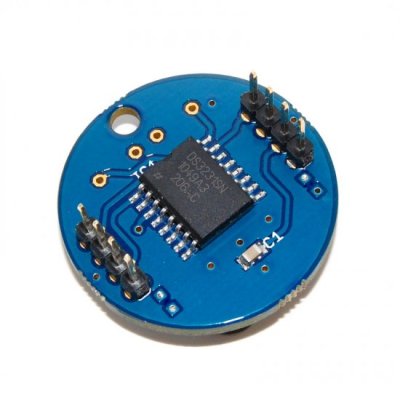
Good RTC ICs like Maxim’s DS3231, used in the Chronodot, can do that. They use temperature correction logic and a crystal oscillator to get as accurate as five parts per million, or under half a second per day. They even have internal calendar functions, taking care of leap years and the day of the week and so on. The downside is the cost: temperature-compensated RTCs cost around $10 in single quantity, which can break the budget for some simple hacks or installations where multiple modules are needed. But there is a very suitable alternative.
What we’re looking for is a middle way: a wall-time solution for a microcontroller project that won’t break the bank (free would be ideal) but that performs pretty well over long periods of time under mellow environmental conditions. The kind of thing you’d use for a clock in your office. We’ll first look at the “obvious” contender, a plain-crystal oscillator solution, and then move on to something experimental and touchy, but free and essentially perfectly accurate over the long term: using power-line frequency as a standard.
Continue reading “Embed With Elliot: We Don’t Need No Stinkin’ RTCs”

